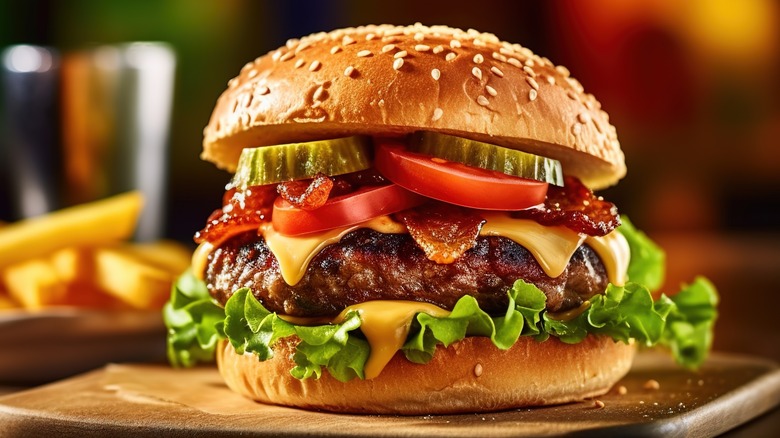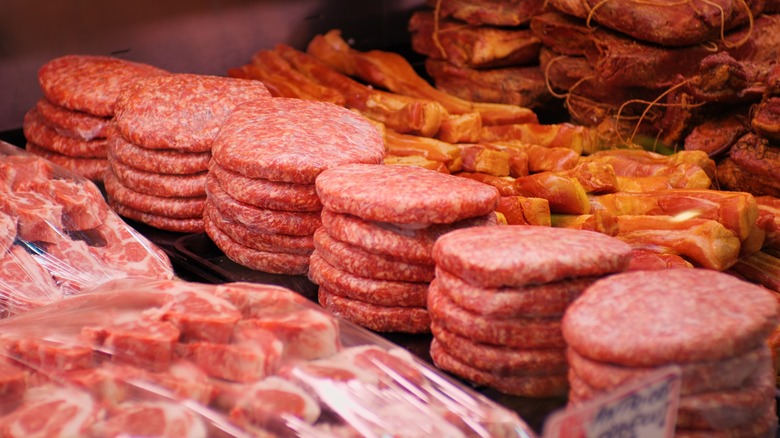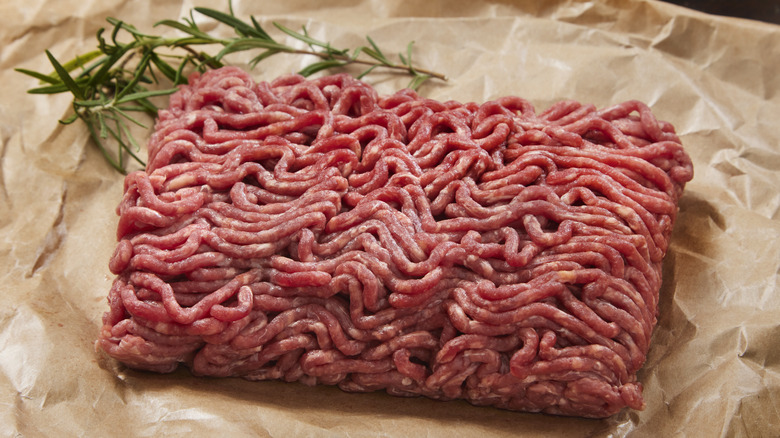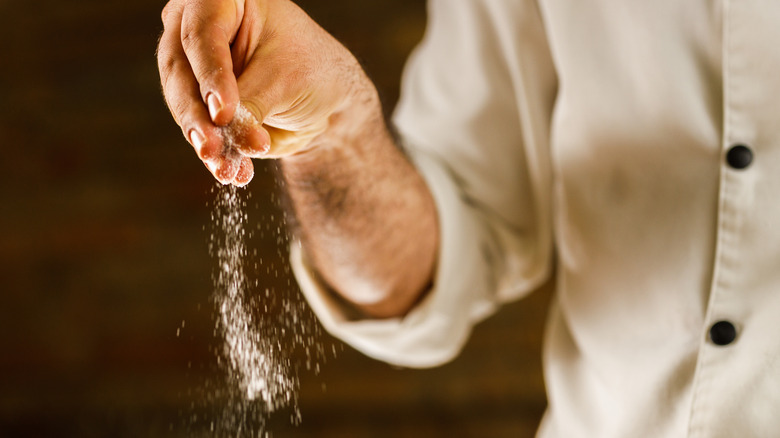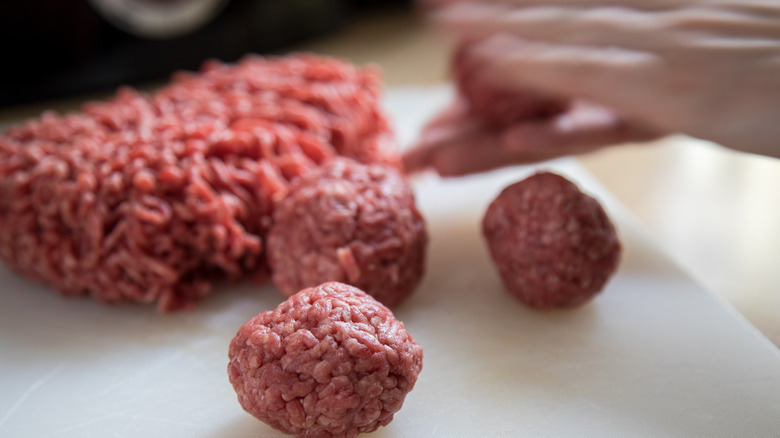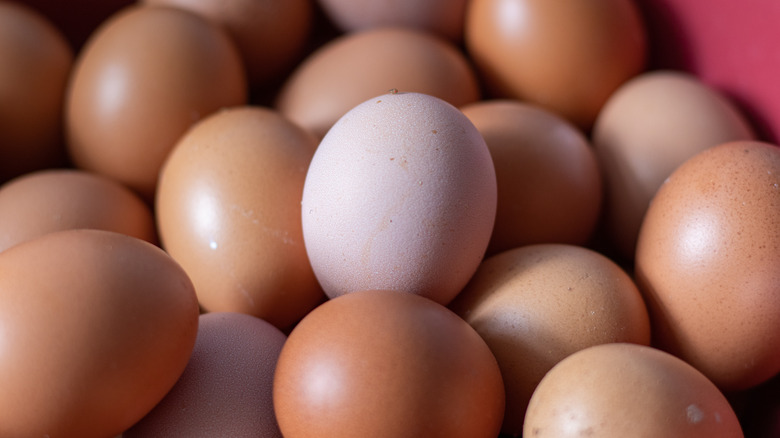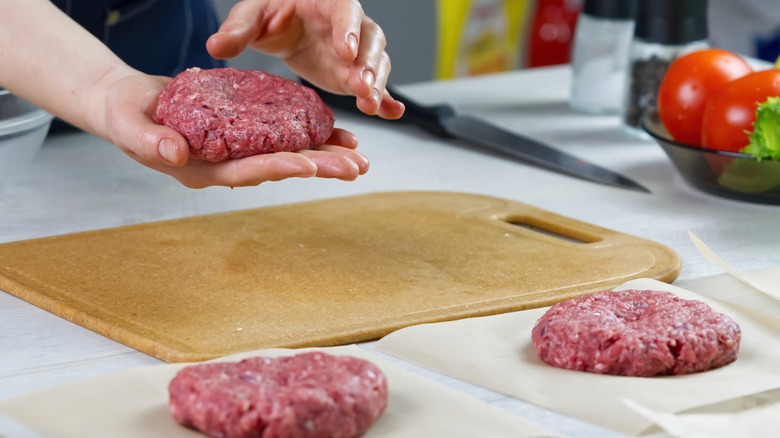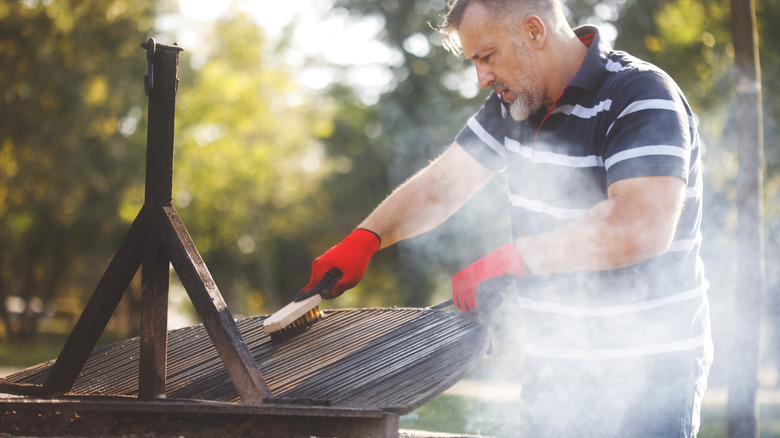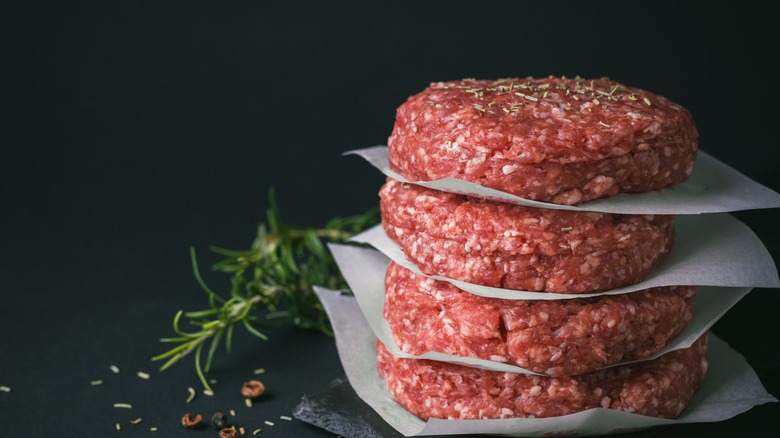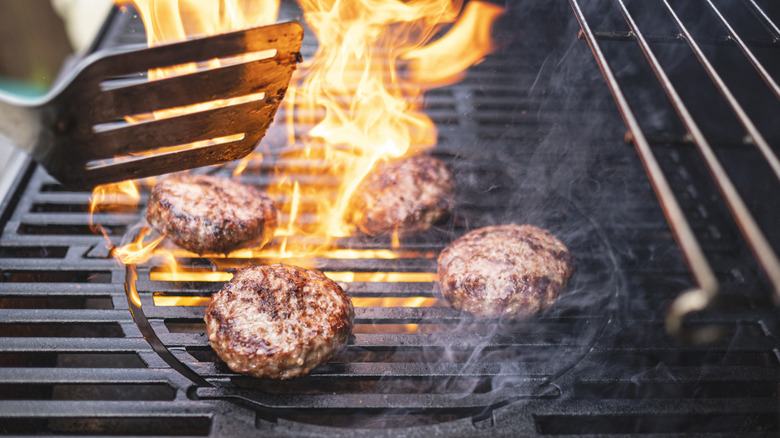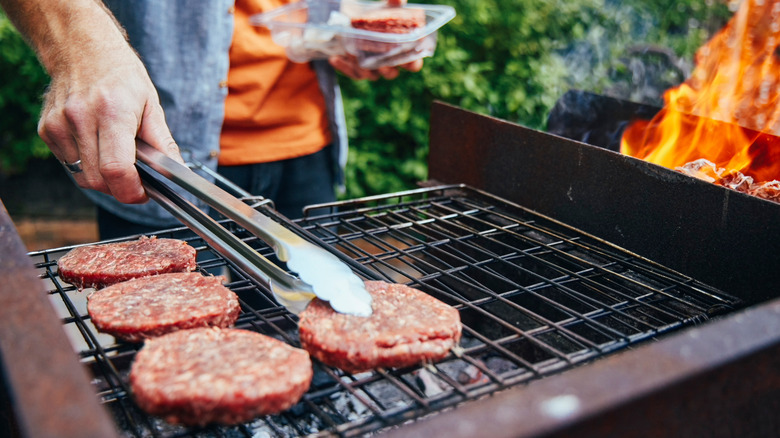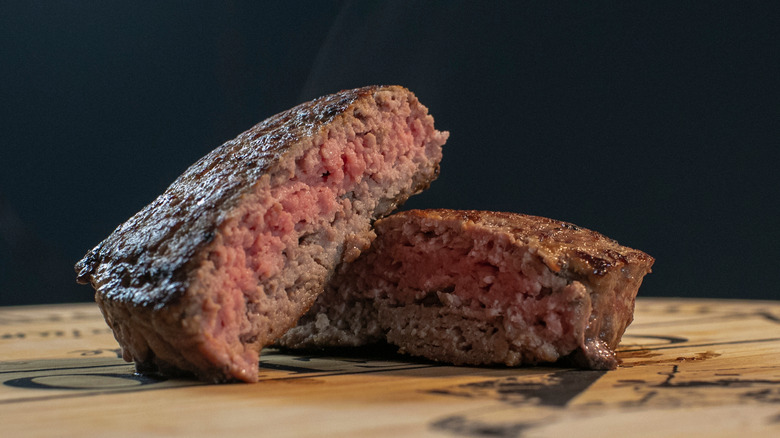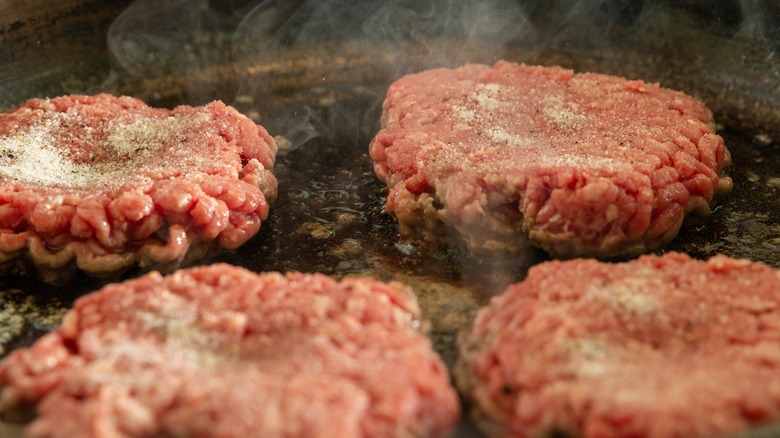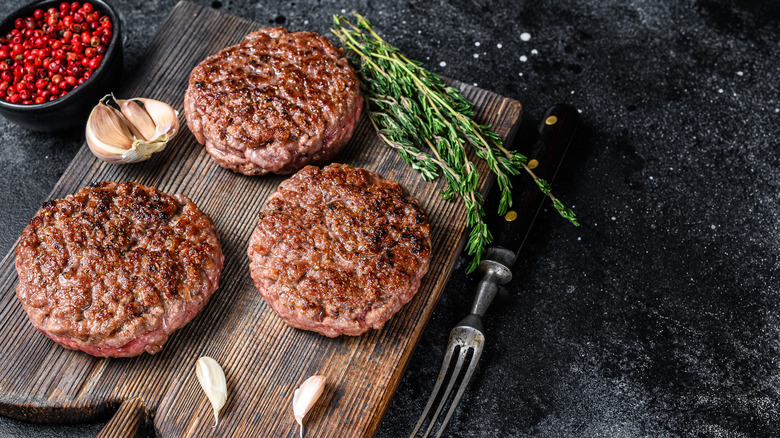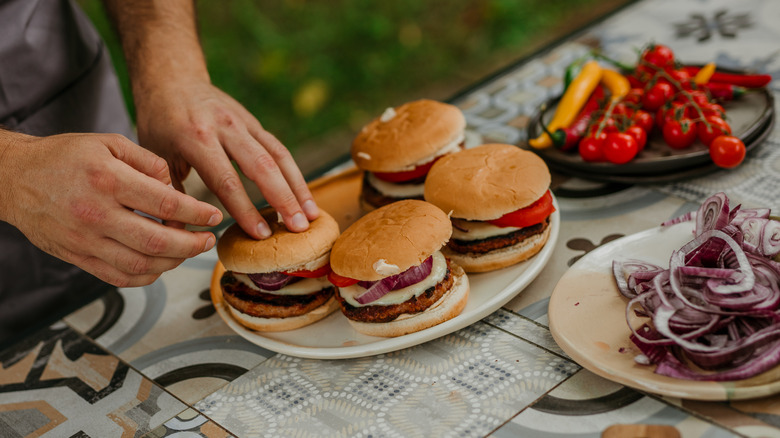The Biggest Mistakes Everyone Makes When Cooking Burgers
There's not much more quintessential than meat and fire — particularly throwing a few burgers on the grill and serving up the juicy beef blend between buns with accouterments from pickles to mayonnaise to lettuce and tomato. But this seemingly simple all-American dish can go wrong in many ways.
Preformed, under-seasoned patties could sabotage you on taste; the wrong fat-to-beef ratio could mean dry, flavorless burgers; even not dimpling your patties — a practice thought by some to be a waste of time — could lead to a less-than-awesome finished product. Even something as seemingly simple as choosing a bun and toppings could do you in if the burger is too small (or too big) for the breading provided. What we're saying is that a lot can go wrong, and a lot of mistakes are made by, well, everyone when cooking burgers. Here are some of the most common burger-making mistakes and how to avoid them in the first place.
Buying pre-formed burgers
We've all seen them: perfectly preformed burger patties waiting behind the butcher counter at the grocery store, or already wrapped and ready to buy in the grab-and-go section. It seems like a time-saving shortcut; when you're throwing a barbecue or party and will also be manning the grill, not having to hand-form 10 to 20 patties could be a 30-minute grace period. So what's the problem? The main issue with pre-shaped patties is that it's never obvious what meat blend has been used, how old it is, or how it's been seasoned.
If you're trying to save on time, buy your meat blend and pre-form your patties a day (or even two) in advance, then store them in the refrigerator in an airtight container. Like when you make meatballs, pre-forming hamburger patties and then letting them rest will allow the meat to come together and will lessen the chances of your burgers falling apart on the grill during party time.
Using ground beef that's too lean
Burgers are completely dependent on their chemical, or beefy, makeup, and a big component of the final taste is your meat-to-fat ratio. One of the main issues a lot of folks end up having with their burgers is that that ratio is off. More fat is better when grilling burgers since it'll help your patties not stick to the grates (as a lot of that fat will be dripping out), create a better crust, and leave you with a juicier burger. An 80-20 ratio is best for your grilling endeavors — even a 70-30 blend will work.
As far as meat blends, skip the fancy stuff like Wagyu or a nice steak to grind yourself. The best meat for a steak dinner doesn't necessarily make a good burger. Chuck is, honestly, your best bet for a good, juicy, tasty burger on the grill. Chuck comes from the shoulder muscle of the cow, and the combination of fat, meat, and muscle makes for a well-balanced bite. If you're feeling adventurous, you can grind your burger with a combination of chuck, aged beef, and something like a brisket, too.
Skimping on the seasoning
As with all things in the kitchen, seasoning can make or break a dish. Think of pasta whose water hasn't been salted; a caprese salad without a finishing splash of fruity olive oil and cracked black pepper; or a burger that's been left with no salt, no pepper, and no love being tossed onto the grill. To properly season a burger, you can use anything from Gordon Ramsay's preferred simple salt and pepper mixture to more complicated blends featuring herbs, garlic, and onion powders.
It's important to note — do not season your meat blend before forming the patties, as the addition of salt will leach out moisture, which is much-needed on a high-temperature grill. Once your patties are formed, a simple but heavy-handed mixture of kosher salt and freshly ground black pepper is all you'll need to complement the beefiness of your burger. But, if you're feeling fancy, burger seasoning blends can be kept simple — like recipes for ones featuring brown sugar, cayenne, garlic powder, and dried parsley.
Overmixing your meat
If you've ever made a cake, you know that one of the cardinal rules of a good bake is to not overmix your batter. Doing so can result in a poorly risen cake without the light, spongey texture you're looking for. Shockingly, the same rules apply to burgers and forming your patties before they hit the grill (or cast iron, for that matter).
When you have your ground chuck out of the refrigerator — and if you're mixing it with another ground cut like brisket or even short rib — you'll want to work to combine in a large, shallow bowl and to only use the tips of your fingers to mix. The more you squeeze, mash, and handle the meat to combine it, the drier, tougher, and less juicy your burger is going to be. By gently using your hands and mixing until the mixtures just come together (and waiting to season until your patties are formed), you won't break down the muscle structure of the meat and you'll be left with well-formed, juicy, and tender burgers. Remember: If you're mixing your mixture and it's beginning to look pale, you've touched it too much. Step away.
Using binders in your meat mixture
Sometimes, a binder or two is necessary in a dish. Take crab cakes, for example. Without the addition of a bit of breadcrumb and/or an egg, that delicious crustacean-laden dish would never stay together — you'd be left with a crumbly (albeit delicious) mess in your sauté pan. Burgers are a bit different. The fat present in ground beef helps your patties stick together so long as you're forming them correctly. However, some folks insist on adding binders, which can be a big mistake.
Adding common binders like breadcrumbs or eggs to your meat mixture is going to give you a flat meatball, not a burger. It'll change the flavor of the beef and may force you to cook longer, losing your ability to have a perfectly medium rare burger. Adding breadcrumbs can give your burger a crumbly, dry texture — the opposite of what we're looking for in the perfect burger. Eggs can change the protein structure of the beef, too, and may lead to a flat, overly smooth bite. So, as a rule, it's best to avoid the binders in your burgers and just stick with your meaty blend and some spices.
Not making patties the right size
Size is important, especially when it comes to your burgers. Depending on where you are or where you're eating, you may see thick, practically half-pound burgers peeking out of buns; you could also see thin smash burgers stacked on top of each other with cheese and perfectly crispy sides. Regardless of what thickness (or thinness) you want in your burger, uniformity is extremely important. When you're forming your patties, aim for one "example", then make all of the other patties as close to that one in size and thickness. Doing so ensures a more even cook on your patties, and less guesswork for you.
If you want a thinner burger — more for the smash burger experience — you can try flattening your patties and then cooking on the grill almost entirely on one side. Flip, then cook for an additional minute or so until you see juices and fat coming through. For a more traditional, thicker burger, make sure the patty is at least at ¾ of an inch thick. The heftier patty can withstand more heat, allowing it to cook evenly without getting too blackened on the outside. Too much thicker, though, and you run the risk of serving a raw burger with an overly charred outside.
Your grill is dirty
You wouldn't cook with a dirty spatula or sauté in a greasy pan. Neither, then, should you be cooking your burgers on a grill that hasn't been cleaned, brushed, and oiled. Putting your perfectly formed patties on a grill that has a bunch of "stuff" stuck to it from the last time you grilled it could mean that your burgers will stick, or, worse, bring with them whatever leftover food was still stuck on.
Cleaning your grill before you throw your patties on is relatively easy. First, you'll want to start with a warm — not hot, not cold — grill, and scrape the grates with a wire brush. This will help loosen and remove any leftover food particles, bits of charcoal, or other nasties that have made their way up. Second, once everything is properly scraped, take an oiled towel or paper towel and wipe the grates down. This will essentially season the grill and help prevent sticking later.
Using frozen or overly-warm meat
Nearly as important as the right temperature on the grill and not over-handling your patties is the temperature of your burgers when they hit the grill. We've likely all seen people bringing a steak up to room temperature before cooking it; or throwing a frozen hamburger patty on a flattop. The fact of the matter is that when it comes to a damn fine burger, you want your formed patties to be a bit north of room temperature when they hit the grill.
First, a frozen patty thrown onto a hot grill may not ever reach the proper temperature. This could lead to a scorched outside and a very undercooked interior. We like a medium rare — sometimes even rare — burger, but this one may be pushing even that. Additionally, meat that gets too hot too fast runs the risk of bacterial growth. No thanks.
Second, your burger patties also shouldn't be warm or room temperature when they start to cook. The warmer your ground beef mixture, the more likely the fat holding everything together is to melt, quickly. The faster the fat melts, the less juicy your burger and the less likely it is to stay together. The absolute best temperature for your burger patties as they hit the grill is cold — not frozen — just out of the fridge is best.
Using the wrong heat while cooking
If you've formed your burgers, seasoned them, let them rest, and are ready to get them out of the fridge and over the open flame, the temperature is the next most important step in your patty process. So, should you use high heat when cooking your burgers? The key to a delicious burger is getting a good crust — essentially caramelizing the outside of the meat. You can only achieve that over very high heat, which will immediately start cooking the outside of your burger and leaving the inside to slowly get up to temperature. If you put your burgers over too low of heat, you'll miss out on the caramelization and, essentially, start steaming the meat first. Preheating your grill and making sure it's at the right temperature before you put the patties on is an important and not-to-be-missed step.
The interior temperature for a well-done burger should be, according to the United States Department of Agriculture, 160 F. For a perfect medium rare, you'll want to go a bit below that and pull your burgers slightly earlier, around 130 F. The interior should be reddish-pink and juicy. Remember that your burgers will keep cooking after you remove them from the heat, so to achieve the absolute best temperature for your burgers, you can pull them off of the heat when they're a bit below your desired doneness.
Touching too much while on the grill
While you're waiting for your burgers to hit your ideal internal temperature and watching for the much-desired caramelization, it's important to not touch, fiddle, or overly mess with the patties. In the same way that you don't want to over-mix or over-handle the burgers when you're forming them, you then, too, want to leave them alone as much as possible. We've all seen movies and television shows featuring people pressing a spatula onto their burgers as they cook on the grill. This is, at its core, a cardinal sin in the world of burger creation. If you take a spatula and press down on a cooking burger, you're essentially pressing out all of the juice, fat, and flavor from your patty which you've lovingly formed. Don't do it.
Additionally, a burger requires one flip on the grill, not two, three, or more. The more you flip and handle the burger, the less likely you'll be to form that caramelized outer crust you're looking for.
Overcooking the burgers
As you're patiently waiting for your burgers to cook on the grill, getting perfectly caramelized and you aren't touching them, you may be wondering how long they'll take to hit that much sought-after medium-rare. Once your grill is hot and ready, put your patties on and cook them for about 2½ to 3 minutes on the first side before flipping them to the second side. Cook another 2½ minutes and, when the meat hits a few degrees shy of 130 F for medium rare, remove them.
Remember: The burgers will continue to cook once you've removed them, so getting them off the heat before you hit the temperature you're looking for will ensure they don't end up more done than you want. Additionally, most chefs agree that well-done is not the most flavorful or desirable temperature for a burger. You can lose a lot of the juiciness in your patty by taking a burger this far.
Skipping the dimple step
It may seem silly — even superfluous — but adding that little dimple into the center of your burger patty does make a difference. Taking your thumb and leaving a small, central indentation in your burger patties before cooking them helps your cooking process by ensuring you have a nice, flat burger that lays nicely on your bun and allows for toppings to be stacked. When a burger hits the hot grill, the heat immediately makes the burger's juices push toward the center of the patty — away from the edges. Without a dimple, this would mean that as the edges of the burger crisp, the center of the burger puffs up, giving the patty a spherical look.
When you add the dimple, the juices will still rush to the center, but they'll puff the middle of your patty up to be even with the rest. Burgers with dimples will also cook more evenly, ensuring you have a nice medium rare or medium burger throughout.
Not resting your burgers
When you pull a steak out of a cast iron pan after it's reached the perfect temperature, or you finally remove the turkey from the oven on Thanksgiving day, you're expected to give either several minutes or more to rest. Not doing so, and, instead, slicing into either immediately means the loss of juices and flavor — resulting in a dry piece of meat and the loss of hours of hard culinary work.
Burgers follow the same rules. When you pull your burgers off of the grill, place them on a grate above a plate to catch any dripping deliciousness — no more than a couple of minutes. This will allow the fat and juice to reabsorb, allowing you to have a juicy burger without the threat of a soggy bottom hamburger bun. Remember that the juices and fat have been forced to the center of your patties during cooking over high heat. Allowing them to rest lets those juices move back and redistribute into the other areas of the burger, meaning an all-over juicy and flavorful experience for your diners.
Wrong buns and toppings
Once your patties are done cooking, have rested, and are ready to be assembled, you'll want only the best cheeses, lettuce, and condiments to complement them. If you're creating cheeseburgers, make sure you're adding the cheese at the right time — after you've already flipped your burger once and have about a minute or two left of cooking time. You can't go wrong with American cheese, cheddar, pepper jack, or Swiss. Just make sure slices are sandwich-sized and not too thick, otherwise you'll run the risk of making a melty mess all over your grill.
After any cheese has been added, toppings can run the gamut from classic tomato and lettuce to fried onion rings and peanut butter. The rule for toppings is to try not to overwhelm your burger and make sure you can fit your mouth around it. Just remember that the beef is still (and should be) the star.
Lastly, buns do make a big difference. If you're in a bind, sandwich bread can work, but the reigning favorite for most is a classic potato roll. It holds up better and is sturdier than buns made with regular wheat flour, and can more easily contain your burger and toppings without becoming a mushy mess. Just do us a favor and skip the lettuce bun.
